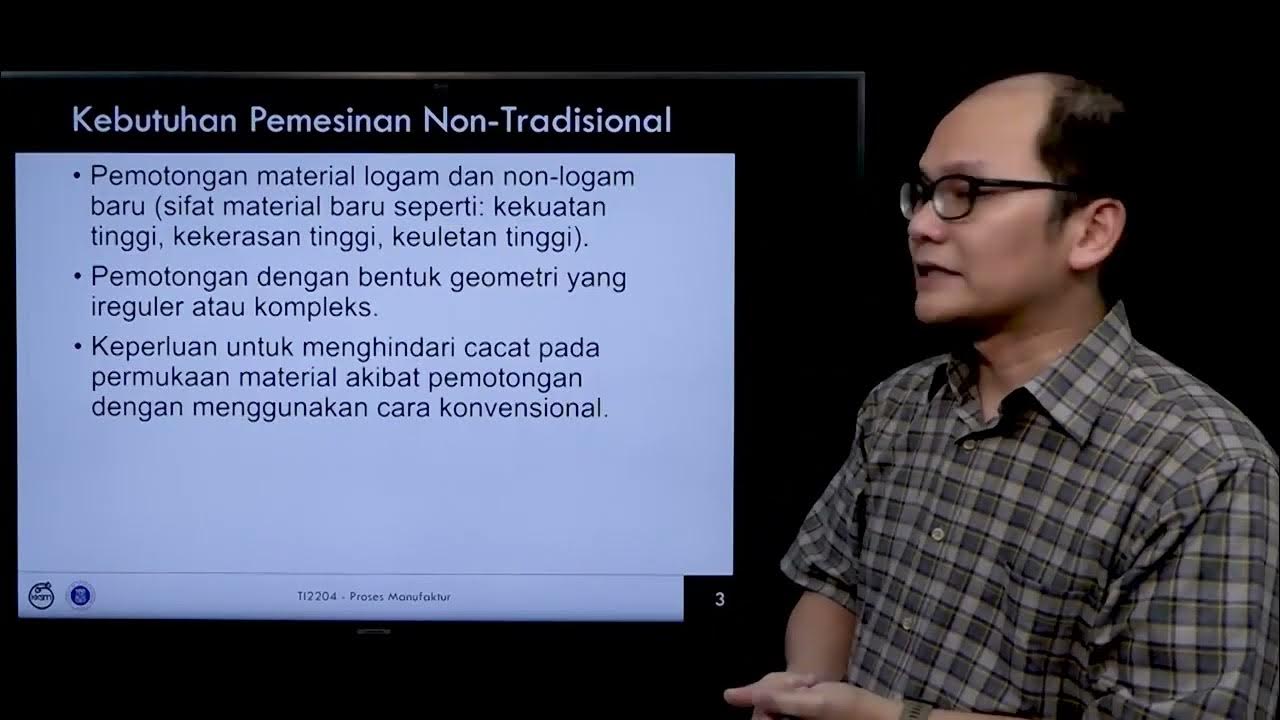Pengetahuan Bahan Teknik
Summary
TLDRThis video script covers the basics of materials science in mechanical engineering, focusing on the properties and types of materials used in machining. It highlights the distinction between metallic and non-metallic materials, explaining their properties such as elasticity, conductivity, and melting points. The lecture explores various metal categories, including heavy, light, noble, heat-resistant, and radioactive metals, and emphasizes the importance of alloys in practical applications, especially iron-based alloys. The speaker provides foundational knowledge for students in machining, offering insights into the materials that form the basis of high-quality engineering products.
Takeaways
- 😀 Understanding materials is fundamental in engineering, especially for mechanical engineering students.
- 😀 Materials science is a basic knowledge that every engineer must master, as it helps in creating quality products and constructions.
- 😀 Materials can be categorized into two main types: metals and non-metals.
- 😀 Metals are commonly used in mechanical engineering, while non-metals are less frequent but still utilized.
- 😀 The properties of metals include elasticity, strength, electrical and heat conductivity, and a high melting point.
- 😀 Metals are also malleable and can be formed into different shapes, such as bending or casting.
- 😀 Metals can conduct electricity and heat, which is not the case for non-metals like plastic.
- 😀 Materials used in mechanical engineering often need to be durable, so the choice of material affects the final product's quality.
- 😀 Iron is a crucial metal in engineering, but it is too soft in its pure form, so it is usually alloyed with other elements like carbon.
- 😀 Iron-based materials (ferrous) and non-iron-based materials (non-ferrous) have different properties and uses in mechanical engineering.
- 😀 Various categories of metals, such as heavy metals (e.g., iron, nickel) and precious metals (e.g., gold, silver), are used for specific applications.
Q & A
What is the significance of material science in mechanical engineering?
-Material science is a fundamental area of knowledge in engineering, particularly in mechanical engineering, as it helps engineers understand and choose the right materials for creating quality products or structures that meet consumer and societal needs.
What are the two main categories of engineering materials?
-The two main categories of engineering materials are metals and non-metals. Metals include materials like iron, copper, and aluminum, while non-metals include materials like glass, wood, plastics, ceramics, and paper.
Why are metals, especially ferrous metals, commonly used in mechanical engineering?
-Metals, especially ferrous metals like iron and steel, are commonly used in mechanical engineering because of their strength, durability, and ability to withstand various forces, making them ideal for creating tools, machinery, and structural components.
What are the key properties of metals as discussed in the transcript?
-Metals have several key properties including elasticity (ability to bend or stretch without breaking), durability (resistance to breakage), high conductivity of electricity and heat, and a high melting point, which makes them suitable for various engineering applications.
What is the difference between ferrous and non-ferrous metals?
-Ferrous metals contain iron, while non-ferrous metals do not. Ferrous metals are typically stronger and more durable, while non-ferrous metals, like aluminum, tend to be lighter and more resistant to corrosion.
What is the role of alloying in metals like iron?
-Alloying improves the properties of metals like iron. For example, adding carbon to iron creates steel, which is stronger and more durable. Pure iron is too soft for practical applications, which is why alloying with elements like carbon is essential in mechanical engineering.
What are the types of metals discussed in the video?
-The video discusses five types of metals: heavy metals (e.g., iron, nickel), light metals (e.g., aluminum), precious metals (e.g., gold, silver), heat-resistant metals (e.g., tungsten), and radioactive metals (e.g., uranium).
What makes precious metals like gold and silver valuable for engineering?
-Precious metals like gold and silver are valuable in engineering because of their rarity, high economic value, and their properties such as resistance to corrosion, making them suitable for use in jewelry and high-end electronic components.
Why is pure iron not suitable for many engineering applications?
-Pure iron is too soft and brittle for most engineering applications. To make it more suitable, it is alloyed with other elements, such as carbon, to create stronger materials like steel.
What specific metals are used in high-temperature applications?
-Metals like tungsten and molybdenum are used in high-temperature applications due to their ability to withstand extreme heat without melting, which makes them valuable in industries that deal with high temperatures.
Outlines

This section is available to paid users only. Please upgrade to access this part.
Upgrade NowMindmap

This section is available to paid users only. Please upgrade to access this part.
Upgrade NowKeywords

This section is available to paid users only. Please upgrade to access this part.
Upgrade NowHighlights

This section is available to paid users only. Please upgrade to access this part.
Upgrade NowTranscripts

This section is available to paid users only. Please upgrade to access this part.
Upgrade NowBrowse More Related Video

Kuliah 2 IBK Sifat Mekanis Bahan part 1

Materiais e Processos de Fabricação para Engenharia de Produção - Propriedades do Materiais

Introduction: Advanced Machining Processes

Proses Pemesinan Non Tradisional part 1

Bonding in Ceramics: Understand the Physical & Chemical Properties of Ceramics | #EME230

Materiais e Processos de Fabricação para Engenharia de Produção - Usinagem não convencional...
5.0 / 5 (0 votes)